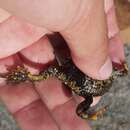pms
nòm ant ël fil


The Magellanic subpolar forests is an ecoregion dominated by trees of the genus Nothofagus; this geographic zone covers the western part of the southern end of South America as well as the extreme southern parts of Argentina and Chile, known as the region Tierra del Fuego; this ecoregion is the southernmost forest biome on Earth. TheMagellanic subpolar forests ecoregion is colder and in parts drier than the Valdivian temperate forests, and in general is floristically poorer.
Faunal species richness and endemism is low; for example, a total of only 168 vertebrates has been recorded here.The fauna is related to that of the bordering ecoregions, especially to that of the Valdivian temperate forests and the Patagonian steppe. Nevertheless, its varied and majestic landscapes that include high mountain peaks, enormous icefields, and innumerable fjords are inhabited by unique and endemic animal and plant species that are sometimes locally abundant within this ecoregion.
Soils of the ecoregion are varied, mostly depending on climate, but are generally acid due to high precipitation, low drainage, and slow decomposition of organic matter in relation to low temperatures. Towards the south and west podsols and acid brown forest soils develop in places with better drainage, and peat accumulates in less drained areas with bogs and tundra vegetation.
The vegetation shows principally two types of forest: chiefly evergreen Guindo Beech (Nothofagus betuloides) forests to the west and deciduous Lenga (Nothofagus pumilio) and Antarctic Beech (Nothofagus antarctica) forests towards the east that extend into Argentina. In Tierra del Fuego the evergreen forests are found to the south and the deciduous forests towards the interior. The deciduous forest is formed by almost pure stands of Nothofagus pumilio at lower elevations, in different combinations with the more ecologically tolerant Nothofagus antarctica, which prevails in more arid situations or less drained soils. In frost pockets a heath dominated by Empetrum and Bolax is found. In humid or wet places of these forests especially rich raised bog-communities grow dominated by Sphagnum, and grasses in the families Juncaceae and Cyperaceae.
Thirteen amphibians are found in the ecoregion, all of whom are anuran taxa. Some species of amphibians are characteristic of the ecoregion including the Patagonian Toad (Nannophryne variegata); Marbled Wood Frog (Batrachyla antartandica), found from Mehuin to the Virtudes Islands; Island Spiny-chest Frog (Alsodes monticola), known only from Inchy, in coastal southern Chile; Gray Wood Frog (Batrachyla leptopus), found from Neuquén to lower Río Negro in Argentina, and Concepción to the Aysén Region in Chile.; Gray Four-eyed Frog (Pleurodema bufoninum), occurring in the Patagonian steppe and subpolar forests; Emerald Forest Frog (Hylorina sylvatica), ranging in Chile from the western versant of the Cordillera de Nahuelbuta to Laguna San Rafael, and in Argentina, found in several locations at Nahuel Huapi National Park (southern Neuquén Province and northwestern Río Negro Province) and at Los Alerces National Park (northern Chubut Province); Banded Wood Frog (Batrachyla taeniata), found from Neuquen Province to the lower Rio Negro Province; Chiloe Island Ground Frog (Eupsophus calcaratus), found from Valdivia to Wellington Island in Puerto Eden, Chile to Tromen Lake and Puelo Lake in Argentina; Darwin's Frog (Rhinoderma darwinii VU), occurring in Chile from the province of Maule south to the province of Aisen, and in the Argentine provinces of Neuquen and Rio Negro.
Several amphibians are strictly endemic to the Magellanic subpolar forests, such as the Puerto Eden Frog (Atelognathus grandisonae), known only from the type locality at Puerto Eden, Wellington Island; Alsodes kaweshkari, found in only two localities: Puerto Edén at Wellington Island and Seno Huemules, both in southern Chile; and Nibaldo's Wood Frog (Batrachyla nibaldoi).